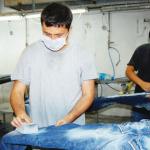After 39 Deaths, Denim Sand Blasting is Banned
The Ministry of Health has announced that it has banned the use of sand and silica powder and crystals in the processing of denim and other textiles, as it leads to the uncurable, and often fatal silicosis disease.
In a written statement, the Ministry referred to a collaboration between the World Health Organisation and the International Labour Organisation, both of whom are trying to reduce the frequency of silicosis in all job types and wipe it out by 2030 as part of their Global Action Plan.
Prevention, protection and check-ups
The statement was published in order to identify the illness at the earliest possible stage and to push people into carrying out preventative measures to protect employers in risky jobs. In recent years dental technicians and denim sand blasters have shown a greater frequency of the silicosis illness. The statement says that wherever it is unavoidable that people come into contact with the material, measures of protection have to be taken. Employers in these branches are also to undergo regular health check-ups.
The Ministry pointed out that denim sand blasting, which creates a faded look for the textile, was forbidden in many European countries and the US because of its health risks.
39 workers died in Turkey
In Turkey, so far 39 denim sand blasters have died of silicosis, most recently Ruhat Yıldırak (24), who had been in hospital for the last two years.
Silicosis is normally an occupational disease associated with people working with stone, such as miners, quarry workers, stone blasters, etc. Silica dust enters the lungs and causes respiratory problems by inflaming and scarring the lungs. Silicosis is irreversible, and particularly the acute form leads to death.
The fashion in denim that is faded and made to look old is achieved by blasting the material with sand from air compressors. Workers using the equipment are then exposed to silica dust.
4,000 workers with silicosis
The Committee for Solidarity with Denim Sandblasters (KTİD) has said that there are around 4,000 denim workers with the disease and that the connection between the occupation and the disease has been known since 2004. (BÇ/AG)












